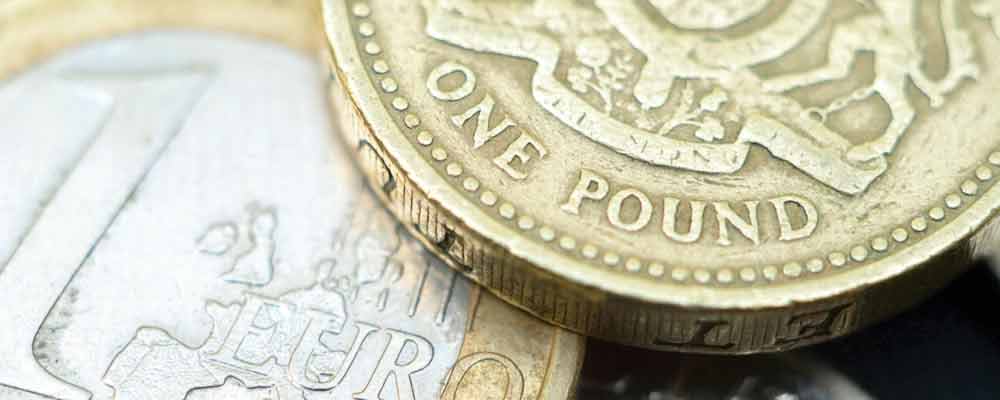- Pound Euro Exchange Rate Has Potential for Great Movement on Thursday’s BoE Rates Announcement.
- UK Consumer Confidence Plummets to 22-Year Low – Post-Brexit economic conditions keep consumers hands away from pockets.
- Half of UK’s £25 Billion Commercial Property Sector on Hold – Panicked investors scrambling to redeem their capital put whole sector at risk of massive depreciation.
- European Uncertainty Stoked as ECB Hints at Stimulus, Italian Bank Crisis Looms – Investors keep the Euro at arms-length amidst post-Brexit occurrences.
The Pound Euro exchange rate has been in decline at a steady pace over the past week as a number of post-Brexit events sought to gut the Pound of any worth in investor’s eyes. Consumer confidence plummeted, over half of the UK’s commercial property investment funds have been frozen and the current account deficit continues to widen.
Initially, the pairing trended somewhat narrowly at the start of the week but that changed the instant the UK’s Markit construction PMI printed at a distressingly low figure of 46.0, showing the sector markedly in contraction.
From then, the pairing continued to slide, briefly experiencing a fresh two-year low of 1.1612 Euros to the Pound, with GBP/EUR sliding ever-closer to the near-parity experienced just after the 2008 World Banking Crisis.
Euro demand has been tempered by the looming Italian bank crisis and the possibility of European Central Bank (ECB) stimulus and as a result, the Pound Euro exchange rate has enjoyed the occasional rally this week as European uncertainty flared. However, Sterling has lacked the ability to hold on to its gains until Friday when it appeared to settle somewhat.
Towards the end of Friday’s session, the Pound Euro exchange rate traded at 1.1724 after appreciating nearly 0.50%.
Sterling (GBP) Ends the Week 3 Cents Lower against the Euro (EUR)
The Pound’s post-Brexit battering continued this week after Monday’s construction sector PMI printed at a heart-sinking 46.0, showing that UK construction is decidedly in contraction. The data was collected from the start of June, and as such the full impact of the Brexit vote on the construction sector will not be known until next month.
Tuesday heralded more bad news as the Bank of England’s (BoE) prognosis was set out in their first stability report of the year. The release highlighted key areas of concern for the post-Brexit economy and overall made the case for a grim short-term future.
Almost every ecostat released over the weak printed unfavourably as the real-world consequences of the Brexit began to, as the BoE put it, ‘crystallise’. Such materialising is evident in the freezing of over half of the UK’s £25 Billion commercial property investment sector. Funds were forced to block withdrawals as panicked investors looking to redeem their capital placed the entire commercial property market at risk.
Euro (EUR) Fails to Attract Investors due to Mixed Data and Looming Italian Bank Crisis
The Eurozone had started to notice recordable pre-Brexit declines over a month before the referendum and post-vote economic circumstances have only lead to further dwindling.
German factory orders failed to reverse their decline in May as both month-on-month and year-on-year figures printed disappointingly below forecasts. German retail suffered a decline as the sector PMI showed a decrease from 54.0 to 51.6, bringing the overall Eurozone retail PMI into contraction at 48.5. Increases in the French retail sector attempted to stem the decline but Italian figures gutted the collated report.
It has been a mixed bag for European ecostats this week for the most part.
European uncertainly has been on the increase thanks to rising concerns surrounding the Italian banking crisis. The banks need a relatively small amount of roughly €40 billion to offset over €200 billion worth of bad debt and keep the sector from collapsing.
New European banking regulations enacted in January state that creditors must incur at least 8% worth of losses on their agreements until the banks are welcome to a taxpayer-funded bailout. These new guidelines were put in place after the over €1.5 trillion bailout bill that landed on tax-payers after reckless practices left some of the world’s major banks collapsing.
Further negative pressure was placed on the common currency as the ECB minutes eluded to the strong possibility of further stimulus in the Eurozone before the end of summer.
Pound Euro Exchange Rate Movement Likely following BoE Rate Announcement on Thursday
As Sterling investors will be carefully eyeing the potential for the Bank of England (BoE) to slash rates on Thursday, it is likely the Pound will continue lacking strength. Most analysts agree a cut is imminent.
The only other UK data release of much worth is the RICS house price report, which will also be released on Thursday. However, it is more than likely any revelations will be drowned out by the BoE’s releases.
Next week includes some fairly influential European ecostats.
The first of which is Tuesday’s German inflation data. As the Eurozone’s biggest player, there is always potential for German data to move markets. Inflation is way below the 2% target preferred by the ECB however, so the Euro could gain a small amount of support if Germany’s inflation gets closer to the 1%-2% ‘sweet spot’.
Wednesday holds Eurozone industrial production, year-on-year, for May. If the data can dodge a pre-Brexit decline then the Euro could expect to enjoy some new-found support.
Finally, Eurozone inflation figures will be published on Friday, as well as a survey of top economic forecasters within the EU. If the survey exudes a decidedly bearish attitude then the common currency could suffer.
Ultimately, it will be down to the BoE’s Thursday rate announcement to stir up any movement in the Pound Euro exchange rate.



